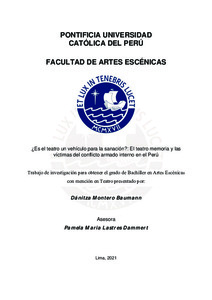| dc.contributor.advisor | Lastres Dammert, Pamela Maria | |
| dc.contributor.author | Montero Baumann, Dánitza | |
| dc.date.accessioned | 2023-08-31T21:34:24Z | |
| dc.date.available | 2023-08-31T21:34:24Z | |
| dc.date.created | 2021 | |
| dc.date.issued | 2023-08-31 | |
| dc.identifier.uri | http://hdl.handle.net/20.500.12404/25822 | |
| dc.description.abstract | El presente trabajo de investigación, consiste en el análisis de cómo el consumo del teatro
memoria logra crear una reparación simbólica para los sobrevivientes del conflicto armado
interno en el Perú. Es así que se plantea que el teatro memoria logra dicha reparación a través
del interaccionismo simbólico de la obra y el impacto de la identificación del espectador con
sus hechos victimizantes en ella, impacto psicosocial.
Para argumentar esta respuesta, se justifica el tema planteado en dos capítulos. En el primero,
se expone el contexto del conflicto armado interno en el Perú dándole importancia a las
secuelas psicosociales que afectan hasta hoy en día a la población sobreviviente. Además, se
explica información relacionada al teatro memoria como el surgimiento, características y
simbologías que contiene; asimismo, se lo abarca tanto de manera general, como relacionada a
nuestro país. Es así que se procede a relacionar al teatro memoria y sus componentes junto con
el contexto histórico del conflicto armado interno en el Perú, teniendo en cuenta la relación
entre estos y cómo se aportan mutuamente en escena. Por otro lado, en el segundo capítulo,
primero se presentan los conceptos de impacto psicosocial e interacción simbólica así como su
relación con las artes escénicas, el teatro memoria y el impacto de estos para con el público.
Finalmente, se expone el significado de reparación simbólica junto a los componentes que
involucra y se los relaciona con el teatro memoria analizando cómo confluyen junto con el
impacto psicosocial y el interaccionismo simbólico hacia una sanación. | es_ES |
| dc.description.abstract | The following research paper analices the way that the consumption of “memory theater”
manages to develop a symbolic reparation around the survivors of the internal armed conflict
in Peru. Therefore, it is suggested that “memory theater” achieves this goal through the
symbolic interactionism of the play and the impact between the audience and the themes and
facts surrounding their victimizing events, through psychosocial impact.
To argue this hypothesis, the issue raised is justified in two chapters. The first one being where
the context of the internal armed conflict is exposed, focusing on the psychosocial
consequences that affect survivors to this day. In addition, it will explain important facts about
“memory theater” like its emergence, characteristics and the symbology used. Likewise, it is
covered in a general way and also in relation to our country. Thus, it proceeds to explain the
relation between “memory theater” and everything that surrounds it, with the context of the
internal armed conflict in Peru, focusing on how they nourish each other on stage. On the other
hand, the second chapter raises concepts around psychosocial impact and symbolic interaction,
their relation to performing arts, “memory theater” and the impact that they have on the
audience. Finally, the meaning of symbolic reparation is exposed, next to the issues it raises
and their relation to memory theater, analyzing the way they converge with psychosocial
impact and symbolic interaction, working towards the healing of the victims. | es_ES |
| dc.language.iso | spa | es_ES |
| dc.publisher | Pontificia Universidad Católica del Perú | es_ES |
| dc.rights | info:eu-repo/semantics/openAccess | es_ES |
| dc.rights.uri | http://creativecommons.org/licenses/by/2.5/pe/ | * |
| dc.subject | Teatro y sociedad--Perú | es_ES |
| dc.subject | Conflicto armado--Perú | es_ES |
| dc.title | ¿Es el teatro un vehículo para la sanación?: El teatro memoria y las víctimas del conflicto armado interno en el Perú | es_ES |
| dc.type | info:eu-repo/semantics/bachelorThesis | es_ES |
| thesis.degree.name | Bachiller en Artes Escénicas con mención en Teatro | es_ES |
| thesis.degree.level | Bachillerato | es_ES |
| thesis.degree.grantor | Pontificia Universidad Católica del Perú. Facultad de Artes Escénicas | es_ES |
| thesis.degree.discipline | Artes Escénicas con mención en Teatro | es_ES |
| renati.advisor.dni | 09340768 | |
| renati.advisor.orcid | https://orcid.org/0000-0001-8221-2071 | es_ES |
| renati.author.dni | 73578251 | |
| renati.discipline | 215586 | es_ES |
| renati.level | https://purl.org/pe-repo/renati/level#bachiller | es_ES |
| renati.type | https://purl.org/pe-repo/renati/type#trabajoDeInvestigacion | es_ES |
| dc.publisher.country | PE | es_ES |
| dc.subject.ocde | https://purl.org/pe-repo/ocde/ford#6.04.04 | es_ES |






